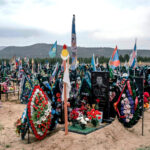Dushanbe wants obedience but treats the region as something to be exploited and ignored.
For 30 years, eastern Tajikistan has been either on the edge of unrest or the scene of fighting.
Fighting broke out again on May 16. The death toll, in the dozens, may be the highest since the 1992-1997 Tajik civil war. The killing of influential local leader Mamadbokir Mamadbokirov on May 22 puts chances for some sort of enduring resolution even further out of reach.
Reports about the mountainous region – known as GBAO, for Gorno-Badakhshan Autonomous Oblast – regularly mention that the people there, often referred to as Pamiris, are Shi’ites, Ismaili Muslims, while most Tajikistan’s population are Sunni Muslims.
But that difference is not the cause of problems between the Tajik government and the Pamiris.
GBAO covers more than 40 percent of Tajikistan but only about 230,000 people live there. The regional capital Khorog sits at an elevation of 2,200 meters and some people live at altitudes of 4,000 meters and higher.
The ruins of the ancient fortresses of Yamchun and Khakha overlook the Pyanj River that now is the border between Tajikistan and Afghanistan. For centuries the peoples living in the high Pamir Mountains in what is now Tajikistan, Afghanistan, and China were isolated from the outside world. They developed their own languages, customs, and traditions.

Outsiders from the lowlands very rarely made their way so far into the mountains until the end of the 19th century, when Tsarist soldiers claimed the territory for Russia and established their main outpost at Khorog.
The Russians built other garrisons in the Pamirs. After 1917, the region became part of the Soviet Union. Russian-language schools, apartment and administrative buildings, and more foreign soldiers appeared. In 1940, a road was built from Dushanbe to Khorog that remains the sole ground link with the rest of the country. The narrow road is mostly unpaved and often closed due to snow or avalanches. Air connections to Khorog were established before the road was built but remain unreliable due to mountain weather.
In an effort to assimilate the Pamiris into the Soviet system, the resettlement of thousands of Pamiris in the lower lands of western Tajikistan started in the 1970s.
And then in late 1991, the Soviet Union collapsed, Tajikistan became an independent country, and a furious period of political activity began.
Tajikistan’s transition to independence did not go smoothly. A former Soviet-era leader seized power and several groups, including the Pamiris, opposed the country’s leadership. On March 26, 1992, there was a large rally outside the president’s residence in Dushanbe and several hundred Pamiris were among the protesters.
The rallies continued, the government bused in supporters and armed them. By May, the civil war was starting.
The group Lali Badakhshan, Rubies of Badakhshan, established in March 1991 to protect the rights of the Pamiri people, sided with the opposition. Together with the Rastokhez (Revival) democratic movement and the Islamic Renaissance Party of Tajikistan (IRPT), it formed the United Tajik Opposition (UTO) that fought against Tajik government forces during the civil war.
The Pamiris who had been resettled fled toward their homeland, but pro-government militias called the Popular Front hunted them and slaughtered many. Those who finally reached GBAO had horror stories to tell about the Tajik government and its allies.
Remote GBAO became something of an opposition stronghold. There was often fighting in the western part of GBAO, but the small and ill-equipped Tajik army was never strong enough to penetrate deeply into the mountainous region.
On June 27, 1997, the UTO and Tajik government signed a peace accord that provided the UTO with 30 percent of the places in government.
The weak Tajik government that emerged under President Emomali Rahmon abided by the terms of the peace accord for several years, but as Rahmon consolidated power, he moved against his former opponents, and some of his wartime allies. He now has a firm grip over almost all of Tajikistan.
Except remote and poorly connected GBAO. The best the Tajik government could do to exert some influence there was to make deals with influential locals, dubbed “informal leaders,” who were nominally loyal to Dushanbe, and usually received a state position as a sign of this alliance.
Over the decades, the Tajik government did little to improve the standard of living in GBAO. Huge amounts of money went into rebuilding Dushanbe and Rahmon’s native Danghara area, but hardly any state money arrived in GBAO.
Tajik authorities left it to the spiritual leader of the Ismailis, the Aga Khan, to develop GBAO. The Aga Khan Fund has allocated money for hybrid agricultural programs to develop crops that can grow at the region’s high altitudes, and for construction of small hydropower plants, a university in Khorog, and other infrastructure projects.
Still, unemployment remains a huge problem. The road from Dushanbe now connects to China, but the people of GBAO do not benefit because much of the cargo passing through the region is believed connected to businesses run by President Rahmon’s family, and exempted from local taxes and fees.
In such an environment, the informal leaders have gained great importance. Local leaders, like Mamadbokirov, help find employment, sometimes though illegal trade in gemstones, contraband cigarettes, or narcotics, for which the government brands them criminals and justifies its security operations in GBAO as efforts to rein in lawlessness.
The first large, post-war security operation in GBAO happened in early 2008, shortly after Mamadbokirov, a former UTO member, had been dismissed from his post as a border guard commander, allegedly for trafficking narcotics. Mamadbokirov led a small group of men who attacked the Interior Ministry building in Khorog.
After several tense days, Mamadbokirov’s group handed over some of their weapons, as part of truce reached with the Tajik government.
In June that year, some 800 people rallied in Khorog against the increase of security forces in GBAO that had followed Mamadbokirov’s raid on the Interior Ministry building. Government representatives negotiated with Mamadbokirov and three other informal leaders – Imomnazar Imomnazarov, Tolib Ayombekov, and Yodgorsho Mamadaslamov – to keep the peace in GBAO.
On July 21, 2012, General Abdullo Nazarov, head of security for GBAO, was killed. The primary suspect in the murder was Ayombekov, a former member of the UTO, who was General Nazarov’s deputy commander at the time. The motive for the killing was over a shipment of contraband cigarettes that had come from Afghanistan through a customs post under Ayombekov’s control.
Two days later a security operation was launched in the Khorog area and when it ended at least 30 civilians, and 17 government soldiers were dead. Imomnazarov was killed in an explosion at his home in August.
A truce was brokered, weapons were handed over to authorities, and fragile stability returned to GBAO.
But the situation has become such that the arrests of locals or an increase in security forces is enough to raise tensions.
In September 2018, President Rahmon visited GBAO and criticized regional authorities for allowing a “state of lawlessness” to develop. He sent additional security forces to the region.
On May 25, 2020, a crowd gathered outside the Security Service building in GBAO’s Rushan district after three locals were detained as part of an operation against smugglers. The crowd eventually rushed the building and freed the three men and tensions were raised again for several days.
And this latest violence started in late November 2021, when security forces shot dead 29-year-old Gulbiddin Ziyobekov. Ziyobekov had earlier slapped around a member of the security forces in GBAO who had molested a young local woman and many in GBAO saw the November security operation as a revenge killing.
Several more people died in unrest that followed. Internet connections to GBAO were cut and not restored until March 21. A commission of state representatives and locals was formed to look into the killing, but their investigation went nowhere.
Earlier this month, on May 14, more than 1,000 people gathered in Khorog demanding the dismissal of the GBAO governor and the release of those detained in the November 2021 unrest. The group warned if their demands were not met, they would hold a public protest on May 16, which they did, only to be met with deadly force that started this latest round of fighting.
The Tajik government wants obedience but offers no benefits as incentive. The people of GBAO regard the government as an outsider that has repeatedly wronged them.
Perhaps the most tragic part of the recent violence in GBAO is knowing it will be repeated.
Source: Eur Asia Net















